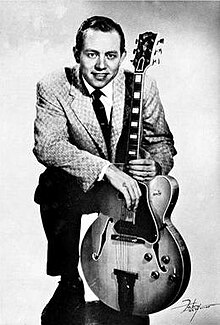Hank Garland
This article needs additional citations for verification. (June 2019) |
Hank Garland | |
|---|---|
 | |
| Background information | |
| Birth name | Walter Louis Garland |
| Born | November 11, 1930 Cowpens, South Carolina, U.S. |
| Died | December 27, 2004 (aged 74) Orange Park, Florida, U.S. |
| Genres | Jazz,[1] country,[1] rock and roll, pop |
| Occupation(s) | Musician |
| Instrument(s) | Guitar, six-string bass |
| Years active | 1942-1961 |
Walter Louis Garland (November 11, 1930 – December 27, 2004), known professionally as Hank Garland, was an American guitarist and songwriter. He started as a country musician, played rock and roll as it became popular in the 1950s, and released a jazz album in 1960. His career was cut short when a car accident in 1961 left him unable to perform.
The Hank Garland biopic Crazy was released in 2008.[2]
Biography
Born in Cowpens, South Carolina,[3] Garland began playing guitar at the age of six, and began to appear on local radio shows at 12. At 14 he moved to Spartanburg, South Carolina where he met Don Reno who gave him lessons, and worked with him on the WSPA-FM station in Spartanburg, both playing lead guitar. [4]
He moved to Nashville at age 16, staying in Ma Upchurch's boarding house, where he roomed with
Garland's guitar drove such classic recordings as
He played with George Shearing and Charlie Parker in New York and went on to record Jazz Winds from a New Direction[6] with Gary Burton on vibraphone, Joe Benjamin on double bass, and Joe Morello on drums.[5] That session took place in Nashville in 1960.
That same year, Garland, along with other members of the
At the request of
In September 1961, a car crash left Garland in a coma.[4] He regained consciousness and recovered with the help of his wife, Evelyn, and two daughters, but due to a brain injury sustained in the car accident, he was unable to return to the studios. After Evelyn died at the age of 38 in a car crash in Milwaukee, Wisconsin on December 2, 1965, Garland's parents took care of him until their deaths. He then went to live with his brother, Billy and wife Amy.
Garland suffered from constant ill health in his later years and died in Orange Park, Florida on December 27, 2004, of complications from a staph infection. He was 74 years old. He is interred in Jacksonville Memory Gardens in Orange Park.
Discography
As leader
- Velvet Guitar (Harmony, 1960)
- After the Riot at Newport with the Nashville All-Stars (RCA Victor, 1961)
- Jazz Winds from a New Direction (Columbia, 1961)
- The Unforgettable Guitar of Hank Garland (Columbia, 1962)
- Hank Garland and His Sugar Footers (Bear Family, 1992)
- Subtle Swing (Sundazed, 2004)
As sideman
- Red Foley and Ernest Tubb, Red and Ernie (Decca, 1956)
- Bobby Helms, Jingle Bell Rock, (Decca 30513A, November 1957)
- Janis Martin, The Female Elvis: The Complete Recordings (1956-57, released on Bear Family Records, 1987)
- Elvis Presley, 50,000,000 Elvis Fans Can't Be Wrong: Elvis' Gold Records, Volume 2 (RCA Victor, 1959)
- Elvis Presley, Elvis Is Back! (RCA Victor, 1960)
- Ray Walker, Everybody's Hits But Mine (Columbia, 1961)
- The Everly Brothers, Both Sides of an Evening (Warner Bros., 1961)
- Don Gibson, Girls, Guitars, and Gibson (RCA Victor, 1961)
- Elvis Presley, Something for Everybody (RCA Victor, 1961)
- Elvis Presley, Follow that Dream (EP) (RCA Victor, 1961)
- Elvis Presley, Pot Luck (RCA Victor, 1962)
- Elvis Presley, Elvis’ Golden Records, Volume 3 (RCA Victor, 1962)
- Skeeter Davis, Blueberry Hill and Other Favorites (RCA Camden, 1965)
Notes
- ^ ISBN 9780793540426. Retrieved 5 October 2014.
- ^ "Crazy". IMDB. Retrieved 11 November 2022.
- ^ Ginell, Richard S. "Hank Garland". AllMusic. Retrieved 16 January 2019.
- ^ a b "Guitarist Hank Garland Dies". Billboard. 28 December 2004. Retrieved 16 January 2019.
- ^ a b c Campilongo, Jim (20 January 2023). "Listen to Hank Garland's 'Jazz Winds From a New Direction' – the Album That Made George Benson Want to Play Jazz". Guitar Player.
- ^ Ginell, Richard S. "Jazz Winds from a New Direction". AllMusic. Retrieved 16 January 2019.
- ISBN 0-7935-9210-0.
References
- Kienzle, Rich (1998). "Hank Garland". In The Encyclopedia of Country Music. Paul Kingsbury, Editor. New York: Oxford University Press. pp. 194–5.
- Hank Garland Biography
- Nashville Sound
